Transkei
1990
"Fossils: 1st set of the series"
| Issue Date |
18.01.1990 |
| ID |
Michel: 246-249 Scott: 231-234.
Stanley Gibbons: 245-248 Yvert: 246-249
UPU: N/A Category: pF |
| Author |
Lambert Kriedemann |
| Stamps in set |
4 |
| Value |
18c Ginkgo koningensis
30c Pseudoctenis spatulafa
40c Rlssikia media
50c Taeniopteris anavolans |
| Size (width x height) |
|
| Layout |
Offset |
| Products |
FDC x1 |
| Paper |
|
| Perforation |
14.25 x 14 |
| Print Technique |
|
| Printed by |
|
| Quantity |
|
| Issuing Authority |
|
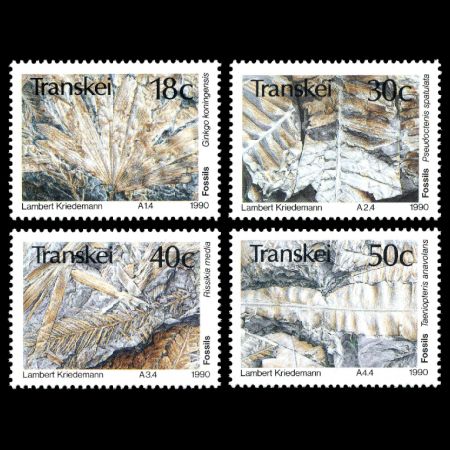
Palaeobotany, the study of fossil plants, is a comparatively young
science. lt is based on the discovery that ancient vegetable matter
preserved in rocks often includes fragments of plants belonging to
genera, orders and even classes which no longer exist. The countryside
in Transkei, 200 million years ago, was not hilly as it is today but
was part of a vast inland plain far from any coastline and traversed by
many meandering rivers bordered by riverine forest belts. Excellently
preserved fossil plants of this age occur in the Molteno Formation
along the higher western border regions of Transkei. The four fossils
illustrated in this set of stamps derive from this geological horizon.
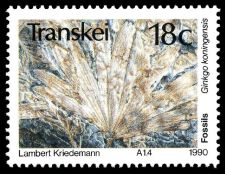 Ginkgo koningensis
Ginkgo koningensis
The genus Ginkgo was first described by the Swedish botanist Linnaeus
in 1771. He is justly considered to be the father of modern biological
classification and it was he who introduced the system of naming plants
by genus and species that it is used throughout the world today. There
is only one species of Ginkgo, namely G. biloba, that still exists
today. It is indigenous only to a small area in China, but specimens
are now growing in many botanical gardens and elsewhere. There are many
fossil species belonging to the genus and these have been collected all
over the world. The species from the 200 million year old Molteno
Formation in Transkei illustrated here is one of the very earliest. |
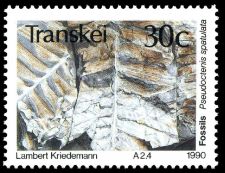 Pseudoctenis
spatulafa Pseudoctenis
spatulafa
This fossil belongs to the cycads, an order of plants represented by
five genera and twenty species in the Molteno Formation. Several of
these species occur in the western uplands of Transkei. Pseudoctenis
spatulata probably looked like the modern cycads (Encephalarfos)
growing in Southern Africa today. In size, however, it was probably
like a bonsai version of the living cycads. P. spatulaia and the other
cycads probably grew everywhere among the undergrowth of the riverine
forest belts.
|
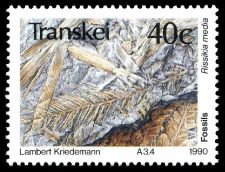 Rlssikia
media Rlssikia
media
The conifers, represented today in Transkei only by the yellow-wood
(Podocarpus) which is confined to patches of wet montane forest, were
rather more common in the region 200 million years ago. Two genera and
three species, including Rissikia media, flourished on those ancient
Molteno plains. Although only known from detached leaves and similarly
isolated male andfemale cones, this conifer species is assumed to have
been a tree of reasonable size. It occurred as a widespread member of
relatively diverse deciduous woodlands.
|
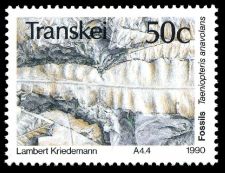 Taeniopteris
anavolans Taeniopteris
anavolans
In addition to the ginkgos, cycads, conifers and a prominent class of
extinct plants known as the seed ferns, a number of genera (e.g.
Taeniopteris) occurred which are known only from their leaves and
cannot be reliably classified in one of the well-established orders of
gymnosperms. Taeniopteris anavolans, although a rare element of that
early Transkei vegetation, produced some of its most conspicuous
foliage. The role that this species with its large strap-shaped leaves
played in the ecology cannot be established today. lt may have occurred
in open bush or dense forest, but it is easiest to imagine it as a
leafy shrub in the shady undergrowth of riverine forests. |
Text: Dr J.M. Anderson, National
Botanical institute Lexlines
Related stamps:
Transkei 1992 "Fossils" 2nd
set of the series"
Transkei 1993 "Fossils" 3rd
set of the serie
Products
| Official and personalized FDC |
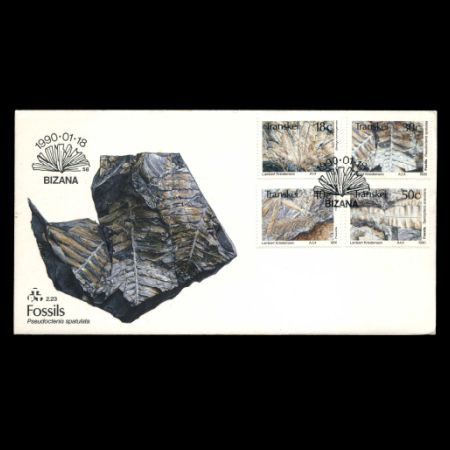 |
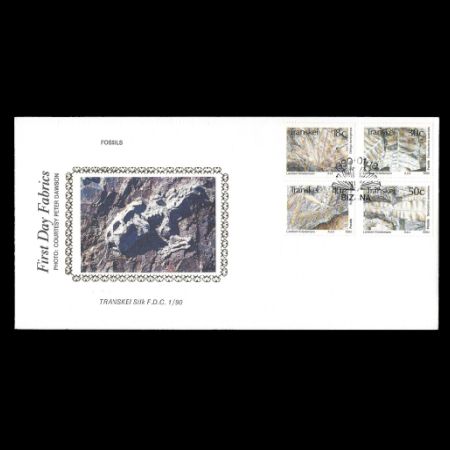 |
| Used FDC |
|
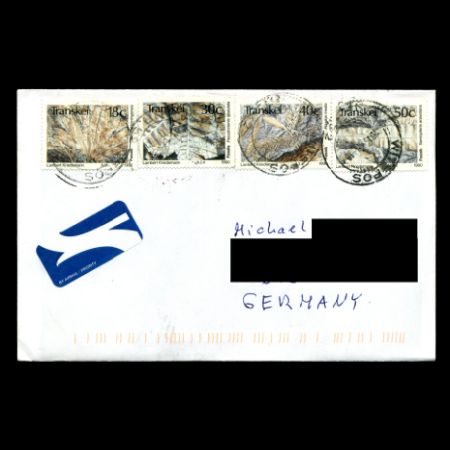 |
|
References:
Inside
text of FDC
Latest
update 14.12.2017
Any feedback, comments or even complaints
are welcome: [email protected] (you
can email me on ENglish, DEutsch, or RUssian)








